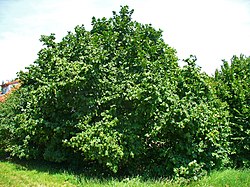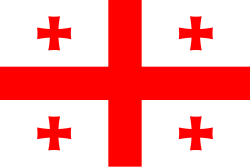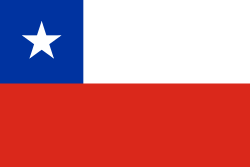Corylus avellana range
- Native continuous range
- ✖ Native isolated population
Caudullo, G., Welk, E., San-Miguel-Ayanz, J., 2017. Chorological maps for the main European woody species. Data in Brief 12, 662-666. DOI: 10.1016/j.dib.2017.05.007
Data: https://doi.org/10.6084/m9.figshare.5101129
References:
- Afonin, A. N., Greene, S. L., Dzyubenko, N. I., Frolov, A. N. (Eds.), 2008. Interactive Agricultural Ecological Atlas of Russia and Neighbouring Countries: Economic Plants and their Diseases, Pests and Weeds. http://www.agroatlas.ru. Accesses in January 2017.
- Babac, M. T., Uslu, E., Bakis, Y. TÜBİVES - Turkish Plants Data Service. Accessed in August 2016.
- Bohn, U., Gollub, G., Hettwer, C., Weber, H., Neuhäuslová, Z., Raus, T., Schlüter, H., 2000. Karte der natürlichen Vegetation Europas; Map of the Natural Vegetation of Europe. Landwirtschaftsverlag. ISBN 9783784338095
- Browicz, K., Zieliński, J., 1982. Chorology of trees and shrubs in south-west Asia and adjacent regions, vol. 1. Polish Scientific Publishers, Warszawa, Poznań. ISBN 9788301039288
- Davis, P. H. (Ed.), 1982. Flora of Turkey and the East Aegean Islands, vol. 7. Edinburgh University Press. ISBN 0852243960.
- European Information System on Forest Genetic Resources. EUFGIS database. Accessed in September 2016
- GBIF.org, 2016. Artdata. DOI: 10.15468/dl.vhlsf9
- GBIF.org, 2016. Banco de Datos de la Biodiversidad de la Comunitat Valenciana. DOI: 10.15468/dl.iru4gq
- GBIF.org, 2016. Botanical Society of the British Isles - Vascular Plants Database additions since 2000. DOI: 10.15468/dl.wzy04e
- GBIF.org, 2016. Botanical Society of the British Isles - Vascular Plants Database. DOI: 10.15468/dl.c7xheb
- GBIF.org, 2016. Cartografía de vegetación a escala de detalle 1:10.000 de la masa forestal de Andalucía. DOI: 10.15468/dl.v7k8vy
- GBIF.org, 2016. Dutch Vegetation Database (LVD). DOI: 10.15468/dl.km20zh
- GBIF.org, 2016. Fieldjournal.org observation database. DOI: 10.15468/dl.qfbdxi
- GBIF.org, 2016. FloVegSI - Floristical and fitocenological database of ZRC SAZU. DOI: 10.15468/dl.emozjq
- GBIF.org, 2016. Flora von Deutschland (Phanerogamen). DOI: 10.15468/dl.jhwqco
- GBIF.org, 2016. FloraCAT: Banco de datos de los cormófitos de Cataluña. DOI: 10.15468/dl.biuda7
- GBIF.org, 2016. Florabank1 - A grid-based database on vascular plant distribution in the northern part of Belgium (Flanders and the Brussels Capital region). DOI: 10.15468/dl.t9ewq8
- GBIF.org, 2016. Floristic Databases of Mecklenburg-Pomerania - Higher Plants. DOI: 10.15468/dl.ttbnoc
- GBIF.org, 2016. Fundación Biodiversidad, Real Jardín Botánico (CSIC): Anthos. Sistema de Información de las plantas de España. DOI: 10.15468/dl.9uo7is
- GBIF.org, 2016. Herbarium of Jyväskylä University Museum. DOI: 10.15468/dl.qlmmfd
- GBIF.org, 2016. INPN - Données flore des CBN agrégées par la FCBN. DOI: 10.15468/dl.gkp7wm
- GBIF.org, 2016. Institute of Dendrology PAS, Flora of Sudety Mountains. DOI: .15468/dl.kybkpr
- GBIF.org, 2016. Karl Franzens University of Graz, Insitute for Botany - Herbarium GZU. DOI: 10.15468/dl.4ok78i
- GBIF.org, 2016. National System of Protected Areas in Poland - Plants. DOI: 10.15468/dl.ym4vmn
- GBIF.org, 2016. Norwegian Species Observation Service. DOI: 10.15468/dl.6domy8
- GBIF.org, 2016. Occurrence Data of Vascular Plants collected or compiled for the Flora of Bavaria. DOI: 10.15468/dl.olxxvo
- GBIF.org, 2016. Sistema de Información de la vegetación Ibérica y Macaronésica. DOI: 10.15468/dl.m8zdd8
- GBIF.org, 2016. University of Vienna, Institute for Botany - Herbarium WU. DOI: 0.15468/dl.x5raqx
- GBIF.org, 2016. Vascular plants in Denmark recorded under the The Nationwide Monitoring and Assessment Programme for the Aquatic and Terrestrial Environments (NOVANA). DOI: 10.15468/dl.hnqokh
- Hultén, E., 1971. Atlas över växternas utbredning i Norden, 2nd edition. Generalstabens litografiska anstalts förlag, Stockholm.
- Hultén, E., Fries, M., 1986. Atlas of North European vascular plants (North of the Tropic of Cancer), Vols. I-III. Koeltz scientific books.
- Jalas, J., Suominen, J.(Eds.), 1976. Atlas Florae Europaeae: distribution of vascular plants in Europe Vol. 3 Salicaceae to Balanophoraceae. Committee for Mapping the Flora of Europe and Societas Biologica Fennica Vanario, Helsinki.
- Jonsell, B. (Ed.), 2000. Flora Nordica, Vol 1: Lycopodiaceae - Polygonaceae. The Royal Swedish Academy of Sciences, Stockholm.
- Meusel, H., Jäger, E. J., Weinert, E. (Eds.), 1965. Vergleichende Chorologie der Zentraleuropäischen Flora, Band I. Gustav Fischer Verlag, Jena.
- Nikolić, T. (Ed.), 2015. Flora Croatica Database. Faculty of Science, University of Zagreb. Accessed in August 2016.
- Real Jardín Botánico, CSIC - Fundación Biodiversidad. Anthos, Information System of the plants of Spain. Accessed in July 2016.
- Sociedade Portuguesa de Botânica. Flora-On: Flora de portugal interactiva. Accessed in July 2016.
- Sokolov S. I., Svjaseva O. A., Kubli V. A., 1980. Areas of distribution of trees and shrubs in the USSR, vol 2. Nauka, Leningrad. (In Russian)
- Strid, A., Tan, K. (eds.), 1997. Flora Hellenica, vol I. Koeltz Scientific Books, Königstein. ISBN 9783874293914
Relevante Bilder
Relevante Artikel
Gemeine HaselDie Gemeine Hasel, auch Haselstrauch oder Haselnussstrauch genannt, ist eine Pflanzenart aus der Familie der Birkengewächse (Betulaceae). Sie ist ein meist rund fünf Meter hoch werdender sommergrüner Strauch, der in Europa und Kleinasien heimisch und in Mitteleuropa sehr häufig ist. Bekannt ist sie für ihre essbaren, seit Jahrtausenden vom Menschen genutzten Früchte, die Haselnüsse. Der Großteil der im Handel erhältlichen Haselnüsse stammt jedoch von der nahe verwandten Lambertshasel. Das Art-Epitheton avellana bezieht sich auf die antike italienische Stadt Abella, heute Avella, in der heutigen Provinz Avellino in Kampanien nahe dem Vesuv. Die Region ist für ihren Haselnussanbau schon seit dem Altertum bekannt. .. weiterlesen


























